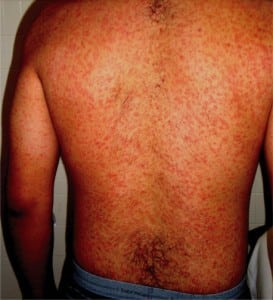| Author | Affiliation |
|---|---|
| Julie A. Gorchynski, MD, MSc | University of Texas, Southwestern, Department of Emergency Medicine; JPS Health Network, Fort Worth, TX |
| Carlyle Langhorn, MD | Texas A&M, Corpus Christi, Department of Emergency Medicine |
| Michael Simmons, MD | Texas A&M, Corpus Christi, Department of Emergency Medicine |
| Daniel Roberts, MD | Texas A&M, Corpus Christi, Department of Emergency Medicine |
A 17-year-old male presented to the emergency department with complaints of fever, rash that originated on the abdomen, malaise, and a cough for 10 days prior to evaluation. The patient reported an encounter with an opossum three days prior to the onset of symptoms. Vital signs were a temperature of 101.2°F, a heart rate of 129 beats per minute, 12 respirations per minute and a blood pressure of 123/76 mmHg. Dermatologic exam revealed a rash on the face, trunk, back, extremities and palms that consisted of multiple small, erythematous maculopapules. Rapid plasma reagin (RPR), monospot and brucella were negative. Rickettsial titers supported the diagnosis of murine typhus. This diagnosis may be suggested clinically by a characteristic rash, normal WBC, low platelets, and elevated liver function tests. Definitive diagnosis requires serology. We prescribed a10-day course of doxycycline, resulting in complete resolution of the rash and constitutional symptoms at three-day follow up.
Murine typhus is a flea-borne illness caused by rickettsia typhi. Rickettsial infections are endemic to hot, humid, usually tropical and subtropical coastal regions.1 Up to 50% develop a rash that is rarely puritic.1 The rash of murine typhus presents as fine erythematous papules on the abdomen, which spreads centripetally to the trunk and extremities but often spares the face, palms, and soles. Symptoms include abrupt onset of high fever, nausea, myalgia, arthralgia and headache.1 The differential should include other rickettsial infections, such as epidemic typhus, murine typhus, scrub typhus, rocky-mountain spotted fever, ehrlichiosis, as well as mononucleosis, borreliosis, drug allergy, meningococcemia, enterovirus infection, typhoid, leptospirosis, toxic shock syndrome, syphilis, rubella, measles, and Kawasaki’s. Its intracellular predilection causes a vasculitis. The prognosis is generally good except in the very young and very old and in the immunosuppressed.1,2 These individuals may progress to multiple organ failure. The mortality rate for treated murine typhus is 1%.1,2 It is imperative to initiate macrolides when the diagnosis is suspected.

Footnotes
Supervising Section Editor: Eric R. Snoey, MD
Submission history: Submitted June 16, 2008; Revision Received October 25, 2008; Accepted December 15, 2008
Full text available through open access at http://escholarship.org/uc/uciem_westjem
Address for Correspondence: Julie Gorchynski, MD, MSc. JPS Health Network, Medical Director, Department of Emergency Medicine, Director of Research, 1500 South Main St., Fort Worth, TX 76104
Email: jgorchyn@msn.com
Conflicts of Interest: By the WestJEM article submission agreement, all authors are required to disclose all affiliations, funding sources, and financial or management relationships that could be perceived as potential sources of bias. The authors disclosed none.
REFERENCES
1. Boostrom A, Beier MS, Macaluso JA, Macaluso KR, Sprenger D, Hayes J, Radulovic S, Azad AF. Geographic association of rickettsia felis-infected opossums with human murine typhus. Emerging Infectious Diseases. 2002;8:549–554. [PMC free article] [PubMed]
2. Raoult D. Philadelphia, PA: Saunders, an imprint of Elsevier Inc; 2008. Goldman: Cecil medicine.


